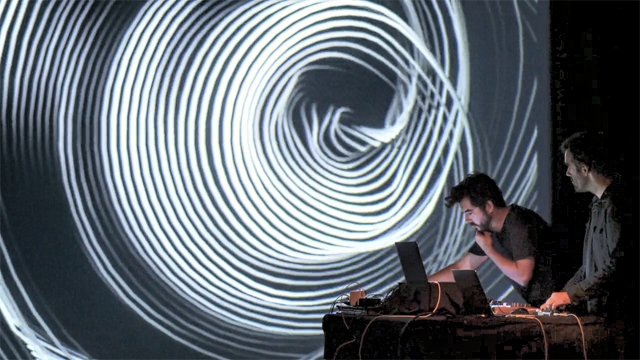
Since 2010, Rodrigo Carvalho (@visiophone) and Miguel Neto have been performing an audiovisual collaboration called Boris Chimp 504, which, in their words, “tells the tale of Boris 504, a chimpanzee who’s exploring the space-time continuum, jumping between several dimensions of the universe. It mixes techno, psychedelia and noise, along with audio-reactive visuals generated in real time, creating an immersive voyage strongly influenced by science fiction, interspersing with the most current scientific discoveries and merging reality and fiction into a narrative of its own.”
Rodrigo and Miguel have done both AV performances and interactive installations at festivals and events. Rodrigo, the visual half of the collaboration, now does all the visuals in VDMX and Vuo.
One of their installations has Boris visiting a renegade moon of Jupiter on a mission to explore its surface.
Another work is a set of audiovisual explorations envisioning Boris crossing interstellar clouds of dust, star clusters, and infinite planetary systems.
In addition to his Boris Chimp 504 work, Rodrigo experiments with live visuals; code; interactive art from screen-based work to interactive installations; audiovisual live acts; and interactive visuals for stage performance. His work is showcased at visiophone-lab. He is additionally the co-founder of the creative studio Openfield. We were able to ask him some questions:
Some of your work uses grids, lines, and circles to call to mind celestial objects. What influenced you in that direction?
Related to the grids, lines and circles: I guess that most of my visual work points to that aesthetic (simple shapes, points and lines, black & white).
Most of my favourite visual artists and influences share that same aesthetics (as Rioji Ikeda, U.V.A, Alva Noto, Adrien M & Claire B, Nonotak, Manfred Mohr, …). One of my favourite motion pieces ever is Larry Cuba’s Calculated Movements (1985).
What made you decide to do “Scanning the Surface of Vale Tudo”?
So, we were asked for a new AV Installation for Iminente Festival, and during our brainstorm we found about a recent discovery related to Jupiter -> 12 new moons were found.
They were very small and running in a different and bigger orbit than the other ones (that is maybe the reason nobody noticed them before). But in this group of new moons, one of them was running in the opposite direction than the others. They called it VALETUDO.
Vale Tudo is Portuguese (also Spanish), It can be translated as “no rules/anything is possible”.
So we found the perfect plot for the new installation. We wrote a little narrative saying that Boris was sent to that moon to explore it, perform some scientific experiments, scan its surface, and to try to understand why the moon is running in the opposite direction.
In creating visuals, do you start out with an idea of what you’d like to see, or play with Vuo’s nodes and see where that takes you?
I guess that a bit of both. Sometimes I have a visual idea and a sketch in paper, and I try to create with Vuo. Sometimes I achieve it, but most frequently while trying to create the initial idea I discover other cool stuff. Also sometimes I also just connect stuff and see what happens.
I see you’ve created a composition in our gallery, Orbits / Spherical coordinates. What else are you doing?
Our current AV Live Performance: “Vanishing Quasars,” made with Vuo.
Your installations use Ableton Live, Vuo, VDMX, Arduino, lighting controls, etc. to create an experience. What advice would you have for someone trying to set up an installation for the first time?
I guess for each specific installation setup, a specific concept is needed. For the first time you want to keep it simple, and not over-complicate with technology. It happens many times, that you spend most of the time trying to solve technical problems, and then you get little time for the most important: the sound and visual experience.
First the idea …
For creating a new installation: it happens often that when we receive an invitation to present, we already have some ideas waiting for the perfect occasion.
And if it makes sense, and the space is good, we start from there. (These “waiting ideas” can be a new tool, a new interaction, working with lights, or a narrative, a concept, etc). Other times we start from zero, and brainstorm to try to find the best solution for that space, event, etc.. Then, we need to know all the info related to the space, the available equipment, and draw a sketch with the implementation in space and all the technical specifications.
Then the implementation …
Then (with the idea) we create all the audiovisual content, program software, interactions, test interfaces, etc.
The last stage would be the implementation in the space. (In this stage you should be pessimistic, because many things can go wrong, so save time for last minute problems.)
For live performances most of the times I use Vuo (or Quartz in the past) in combination with VDMX. I think is the best workflow ever for live performance. You can create small and independent compositions, publish the outputs you want to manipulate, and then control everything live from VDMX.
Comments